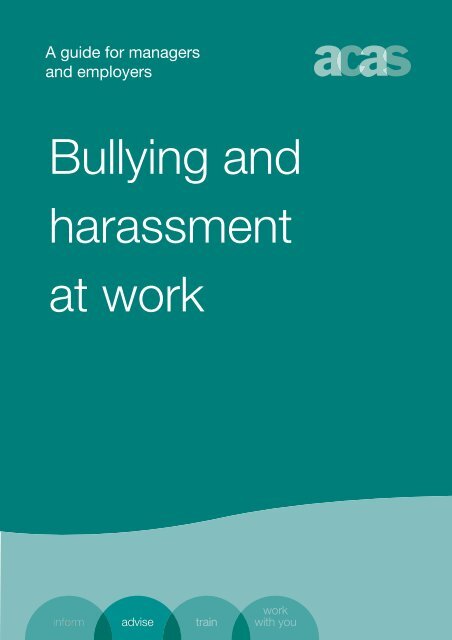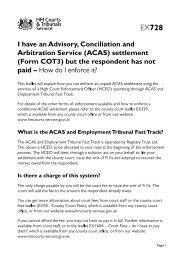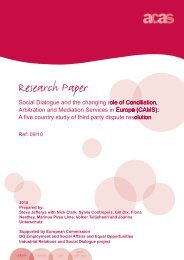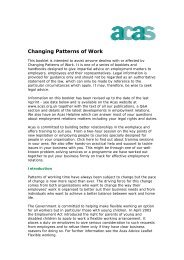Bullying and harassment at work: a guide for managers and ... - Acas
Bullying and harassment at work: a guide for managers and ... - Acas
Bullying and harassment at work: a guide for managers and ... - Acas
Create successful ePaper yourself
Turn your PDF publications into a flip-book with our unique Google optimized e-Paper software.
A <strong>guide</strong> <strong>for</strong> <strong>managers</strong><br />
<strong>and</strong> employers<br />
<strong>Bullying</strong> <strong>and</strong><br />
<strong>harassment</strong><br />
<strong>at</strong> <strong>work</strong>
<strong>Acas</strong> can help with your<br />
employment rel<strong>at</strong>ions needs<br />
Every year <strong>Acas</strong> helps employers <strong>and</strong> employees from thous<strong>and</strong>s of<br />
<strong>work</strong>places. Th<strong>at</strong> means we keep right up to d<strong>at</strong>e with today’s<br />
employment rel<strong>at</strong>ions issues – such as discipline <strong>and</strong> grievance h<strong>and</strong>ling,<br />
preventing discrimin<strong>at</strong>ion <strong>and</strong> communic<strong>at</strong>ing effectively in <strong>work</strong>places.<br />
Make the most of our practical experience <strong>for</strong> your organis<strong>at</strong>ion – find out<br />
wh<strong>at</strong> we can do <strong>for</strong> you.<br />
We in<strong>for</strong>m<br />
We answer your questions, give you the facts you need <strong>and</strong> talk through<br />
your options. You can then make in<strong>for</strong>med decisions. Contact us to keep<br />
on top of wh<strong>at</strong> employment rights legisl<strong>at</strong>ion means in practice – be<strong>for</strong>e it<br />
gets on top of you. Call our helpline 08457 47 47 47 or visit our website<br />
www.acas.org.uk.<br />
We advise <strong>and</strong> <strong>guide</strong><br />
We give you practical know-how on setting up <strong>and</strong> keeping good<br />
rel<strong>at</strong>ions in your organis<strong>at</strong>ion. Look <strong>at</strong> our public<strong>at</strong>ions on the website<br />
or ask our helpline to put you in touch with your local <strong>Acas</strong> adviser.<br />
Our Equality Direct helpline 08456 00 34 44 advises on equality issues,<br />
such as discrimin<strong>at</strong>ion.<br />
We train<br />
From a two-hour session on the key points of new legisl<strong>at</strong>ion or employing<br />
people to courses specially designed <strong>for</strong> people in your organis<strong>at</strong>ion, we<br />
offer training to suit you. Look on the website <strong>for</strong> wh<strong>at</strong> is coming up in<br />
your area <strong>and</strong> to book a place or talk to your local <strong>Acas</strong> office about our<br />
tailored services.<br />
We <strong>work</strong> with you<br />
We offer h<strong>and</strong>s-on practical help <strong>and</strong> support to tackle issues in your<br />
business with you. This might be through one of our well-known<br />
problem-solving services. Or a programme we have <strong>work</strong>ed out together<br />
to put your business firmly on track <strong>for</strong> effective employment rel<strong>at</strong>ions.<br />
You will meet your <strong>Acas</strong> adviser <strong>and</strong> discuss exactly wh<strong>at</strong> is needed<br />
be<strong>for</strong>e giving any go-ahead.
Everyone should be tre<strong>at</strong>ed with<br />
dignity <strong>and</strong> respect <strong>at</strong> <strong>work</strong>.<br />
<strong>Bullying</strong> <strong>and</strong> <strong>harassment</strong> of any kind are in no-one’s interest <strong>and</strong> should not<br />
be toler<strong>at</strong>ed in the <strong>work</strong>place. This leaflet is designed to offer practical advice<br />
to employers to help them prevent bullying <strong>and</strong> <strong>harassment</strong> <strong>and</strong> to deal with<br />
any cases th<strong>at</strong> occur. It includes <strong>guide</strong>lines <strong>for</strong> the development of policies<br />
<strong>and</strong> procedures.<br />
Wh<strong>at</strong> is bullying <strong>and</strong> <strong>harassment</strong>?<br />
Examples <strong>and</strong> definitions of wh<strong>at</strong> may be considered bullying <strong>and</strong> <strong>harassment</strong><br />
are provided below <strong>for</strong> guidance. For practical purposes those making a<br />
complaint usually define wh<strong>at</strong> they mean by bullying or <strong>harassment</strong> –<br />
something has happened to them th<strong>at</strong> is unwelcome, unwarranted <strong>and</strong><br />
causes a detrimental effect. If employees 1 complain they are being bullied or<br />
harassed, then they have a grievance which must be dealt with regardless of<br />
whether or not their complaint accords with a st<strong>and</strong>ard definition.<br />
Is sexual <strong>harassment</strong> different?<br />
Harassment of a sexual n<strong>at</strong>ure is one of the most common <strong>for</strong>ms of<br />
<strong>harassment</strong> <strong>and</strong> is specifically outlawed by the Equality Act 2010 as is<br />
<strong>harassment</strong> rel<strong>at</strong>ed to relevant protected characteristics. It is in the interest of<br />
your organis<strong>at</strong>ion <strong>for</strong> you to take steps to make clear wh<strong>at</strong> sort of behaviour<br />
would be considered sexual <strong>harassment</strong>.<br />
How can bullying <strong>and</strong> <strong>harassment</strong> be recognised?<br />
There are many definitions of bullying <strong>and</strong> <strong>harassment</strong>. <strong>Bullying</strong> may be<br />
characterised as:<br />
Offensive, intimid<strong>at</strong>ing, malicious or insulting behaviour, an abuse or<br />
misuse of power through means th<strong>at</strong> undermine, humili<strong>at</strong>e, denigr<strong>at</strong>e or<br />
injure the recipient.<br />
1 The term ‘employees’ is used to cover all those who <strong>work</strong> <strong>for</strong> someone else r<strong>at</strong>her than on their own<br />
account, regardless of whether they are employed strictly under a contract of employment.<br />
A GUIDE FOR MANAGERS AND EMPLOYERS 1
Harassment as defined in the Equality Act 2010 is<br />
Unwanted conduct rel<strong>at</strong>ed to a relevant protected characteristic, which<br />
has the purpose or effect of viol<strong>at</strong>ing an individual’s dignity or cre<strong>at</strong>ing an<br />
intimid<strong>at</strong>ing, hostile, degrading, humili<strong>at</strong>ing or offensive environment <strong>for</strong><br />
th<strong>at</strong> individual.<br />
Behaviour th<strong>at</strong> is considered bullying by one person may be considered firm<br />
management by another. Most people will agree on extreme cases of bullying<br />
<strong>and</strong> <strong>harassment</strong> but it is sometimes the ‘grey’ areas th<strong>at</strong> cause most<br />
problems. It is good practice <strong>for</strong> employers to give examples of wh<strong>at</strong> is<br />
unacceptable behaviour in their organis<strong>at</strong>ion <strong>and</strong> this may include:<br />
●●<br />
●●<br />
●●<br />
●●<br />
●●<br />
●●<br />
●●<br />
●●<br />
●●<br />
●●<br />
spreading malicious rumours, or insulting someone by word or behaviour<br />
copying memos th<strong>at</strong> are critical about someone to others who do not need<br />
to know<br />
ridiculing or demeaning someone – picking on them or setting them up<br />
to fail<br />
exclusion or victimis<strong>at</strong>ion<br />
unfair tre<strong>at</strong>ment<br />
overbearing supervision or other misuse of power or position<br />
unwelcome sexual advances – touching, st<strong>and</strong>ing too close, display of<br />
offensive m<strong>at</strong>erials, asking <strong>for</strong> sexual favours, making decisions on the<br />
basis of sexual advances being accepted or rejected<br />
making thre<strong>at</strong>s or comments about job security without found<strong>at</strong>ion<br />
deliber<strong>at</strong>ely undermining a competent <strong>work</strong>er by overloading <strong>and</strong> constant<br />
criticism<br />
preventing individuals progressing by intentionally blocking promotion or<br />
training opportunities.<br />
<strong>Bullying</strong> <strong>and</strong> <strong>harassment</strong> is not necessarily face to face, it may occur through<br />
written communic<strong>at</strong>ions, visual images (<strong>for</strong> example pictures of a sexual<br />
n<strong>at</strong>ure or embarrassing photographs of colleagues), email, phone, <strong>and</strong><br />
autom<strong>at</strong>ic supervision methods – such as computer recording of downtime<br />
from <strong>work</strong>, or recording of telephone convers<strong>at</strong>ions – if these are not<br />
universally applied to all <strong>work</strong>ers.<br />
2<br />
BULLYING AND HARASSMENT AT WORK
<strong>Bullying</strong> <strong>and</strong> <strong>harassment</strong> can often be hard to recognise – symptoms may not<br />
be obvious to others, <strong>and</strong> may be insidious. Those on the receiving end may<br />
think ‘perhaps this is normal behaviour in this organis<strong>at</strong>ion’. They may be<br />
anxious th<strong>at</strong> others will consider them weak, or not up to the job, if they find<br />
the actions of others intimid<strong>at</strong>ing.<br />
They may be accused of ‘overreacting’, <strong>and</strong> worry th<strong>at</strong> they won’t be believed<br />
if they do report incidents. People being bullied or harassed may sometimes<br />
appear to overreact to something th<strong>at</strong> seems rel<strong>at</strong>ively trivial but which may<br />
be the ‘last straw’ following a series of incidents. There is often fear of<br />
retribution if they do make a complaint. Colleagues may be reluctant to come<br />
<strong>for</strong>ward as witnesses, as they too may fear the consequences <strong>for</strong> themselves.<br />
They may be so relieved not to be the subject of the bully themselves th<strong>at</strong><br />
they collude with the bully as a way of avoiding <strong>at</strong>tention.<br />
Why do employers need to take action on bullying<br />
<strong>and</strong> <strong>harassment</strong>?<br />
<strong>Bullying</strong> <strong>and</strong> <strong>harassment</strong> are not only unacceptable on moral grounds but<br />
may, if unchecked or badly h<strong>and</strong>led, cre<strong>at</strong>e serious problems <strong>for</strong> an<br />
organis<strong>at</strong>ion including:<br />
●●<br />
●●<br />
●●<br />
●●<br />
●●<br />
●●<br />
●●<br />
●●<br />
poor morale <strong>and</strong> poor employee rel<strong>at</strong>ions<br />
loss of respect <strong>for</strong> <strong>managers</strong> <strong>and</strong> supervisors<br />
poor per<strong>for</strong>mance<br />
lost productivity<br />
absence<br />
resign<strong>at</strong>ions<br />
damage to company reput<strong>at</strong>ion<br />
tribunal <strong>and</strong> other court cases <strong>and</strong> payment of unlimited compens<strong>at</strong>ion.<br />
It is in every employer’s interests to promote a safe, healthy <strong>and</strong> fair<br />
environment in which people can <strong>work</strong>.<br />
A GUIDE FOR MANAGERS AND EMPLOYERS 3
Summary of the law<br />
Harassment<br />
The Equality Act 2010 uses a single definition of <strong>harassment</strong> to cover the<br />
relevant protected characteristics. Employees can complain of behaviour th<strong>at</strong><br />
they find offensive even if it is not directed <strong>at</strong> them.<br />
Harassment is “unwanted conduct rel<strong>at</strong>ed to a relevant protected<br />
characteristic, which has the purpose or effect of viol<strong>at</strong>ing an individual’s<br />
dignity or cre<strong>at</strong>ing an intimid<strong>at</strong>ing, hostile, degrading, humili<strong>at</strong>ing or offensive<br />
environment <strong>for</strong> th<strong>at</strong> individual”.<br />
The relevant protected characteristics are age, disability, gender reassignment,<br />
race, religion or belief, sex, <strong>and</strong> sexual orient<strong>at</strong>ion.<br />
Example:<br />
Paul is disabled <strong>and</strong> is claiming <strong>harassment</strong> against his line<br />
manager after she frequently teased <strong>and</strong> humili<strong>at</strong>ed him about his<br />
disability. Richard shares an office with Paul <strong>and</strong> he too is claiming<br />
<strong>harassment</strong>, even though he is not disabled, as the manager’s<br />
behaviour has also cre<strong>at</strong>ed an offensive environment <strong>for</strong> him.<br />
In addition, the complainant need not possess the relevant characteristic<br />
themselves <strong>and</strong> can be because of their associ<strong>at</strong>ion with a person who has a<br />
protected characteristic, or because they are wrongly perceived to have one, or<br />
are tre<strong>at</strong>ed as if they do. Harassment applies to all protected characteristics<br />
except <strong>for</strong> pregnancy <strong>and</strong> m<strong>at</strong>ernity where any unfavourable tre<strong>at</strong>ment may be<br />
considered discrimin<strong>at</strong>ion, <strong>and</strong> marriage <strong>and</strong> civil partnership where there is no<br />
significant evidence th<strong>at</strong> it is needed.<br />
4<br />
BULLYING AND HARASSMENT AT WORK
Example:<br />
Steve is continually being called gay <strong>and</strong> other rel<strong>at</strong>ed names by a<br />
group of employees <strong>at</strong> his <strong>work</strong>. Derog<strong>at</strong>ory homophobic<br />
comments have been posted on the staff noticeboard about him<br />
by people from this group. Steve was recently physically pushed to<br />
the floor by one member of the group but is too scared to take<br />
action. Steve is not gay but heterosexual; furthermore the group<br />
know he isn’t gay. This is <strong>harassment</strong> rel<strong>at</strong>ed to sexual orient<strong>at</strong>ion.<br />
Harassment <strong>at</strong> <strong>work</strong> by others<br />
An employee can make a complaint against their employer where they are<br />
harassed by someone who doesn’t <strong>work</strong> <strong>for</strong> th<strong>at</strong> employer such as a<br />
customer, client or passenger. As an employer, once you are aware of this<br />
unwanted behaviour you should take reasonable <strong>and</strong> proportion<strong>at</strong>e action to<br />
address the issues.<br />
Example:<br />
Chris manages a Council Benefits Office. One of his staff, Raj, is a<br />
Sikh. Raj mentions to Chris th<strong>at</strong> he is feeling unhappy after a<br />
claimant made derog<strong>at</strong>ory remarks regarding his faith in his<br />
hearing. Chris is concerned <strong>and</strong> monitors the situ<strong>at</strong>ion. Within a<br />
few days the claimant makes further offensive remarks. Chris<br />
reacts by having a word with the claimant, pointing out th<strong>at</strong> this<br />
behaviour is unacceptable. He considers following it up with a letter<br />
to him pointing out th<strong>at</strong> he will ban him if this happens again. Chris<br />
keeps Raj in the picture with the actions he is taking <strong>and</strong> believes<br />
he is taking reasonable steps to protect Raj from <strong>harassment</strong>.<br />
<strong>Bullying</strong><br />
<strong>Acas</strong> characterises bullying as offensive, intimid<strong>at</strong>ing, malicious or insulting<br />
behaviour, an abuse or misuse of power through means th<strong>at</strong> undermine,<br />
humili<strong>at</strong>e, denigr<strong>at</strong>e or injure the recipient.<br />
The impact on the individual can be the same as <strong>harassment</strong> <strong>and</strong> the words<br />
bullying <strong>and</strong> <strong>harassment</strong> are often used interchangeably in the <strong>work</strong>place.<br />
A GUIDE FOR MANAGERS AND EMPLOYERS 5
Unless bullying amounts to conduct defined as <strong>harassment</strong> in the Equality Act<br />
2010 it is not possible to make a complaint to an Employment Tribunal about it.<br />
Unfair dismissal<br />
Employers have a ‘duty of care’ <strong>for</strong> all their employees. If the mutual trust <strong>and</strong><br />
confidence between employer <strong>and</strong> employee is broken – <strong>for</strong> example, through<br />
bullying <strong>and</strong> <strong>harassment</strong> <strong>at</strong> <strong>work</strong> – then an employee can resign <strong>and</strong> claim<br />
‘constructive dismissal’ on the grounds of breach of contract. Employers are<br />
usually responsible in law <strong>for</strong> the acts of their <strong>work</strong>ers.<br />
Health <strong>and</strong> safety<br />
Breach of contract may also include the failure to protect an employee’s health<br />
<strong>and</strong> safety <strong>at</strong> <strong>work</strong>. Under the Health <strong>and</strong> Safety <strong>at</strong> Work Act 1974 employers<br />
are responsible <strong>for</strong> the health, safety <strong>and</strong> welfare <strong>at</strong> <strong>work</strong> of all employees.<br />
For more in<strong>for</strong>m<strong>at</strong>ion visit www.hse.gov.uk.<br />
Wh<strong>at</strong> should employers do about bullying <strong>and</strong><br />
<strong>harassment</strong>?<br />
First, consider framing a <strong>work</strong>place policy. This need not be over-elabor<strong>at</strong>e,<br />
especially <strong>for</strong> small firms, <strong>and</strong> might be included in other personnel policies,<br />
but a checklist <strong>for</strong> a specific policy on bullying <strong>and</strong> <strong>harassment</strong> could include<br />
the following:<br />
●●<br />
●●<br />
●●<br />
●●<br />
●●<br />
●●<br />
●●<br />
●●<br />
st<strong>at</strong>ement of commitment from senior management<br />
acknowledgement th<strong>at</strong> bullying <strong>and</strong> <strong>harassment</strong> are problems <strong>for</strong> the<br />
organis<strong>at</strong>ion<br />
clear st<strong>at</strong>ement th<strong>at</strong> bullying <strong>and</strong> <strong>harassment</strong> is unlawful, will not be<br />
toler<strong>at</strong>ed <strong>and</strong> th<strong>at</strong> decisions should not be taken on the basis or whether<br />
someone submitted to or rejected a particular instance of <strong>harassment</strong><br />
examples of unacceptable behaviour<br />
st<strong>at</strong>ement th<strong>at</strong> bullying <strong>and</strong> <strong>harassment</strong> may be tre<strong>at</strong>ed as disciplinary offences<br />
the steps the organis<strong>at</strong>ion takes to prevent bullying <strong>and</strong> <strong>harassment</strong><br />
responsibilities of supervisors <strong>and</strong> <strong>managers</strong><br />
confidentiality <strong>for</strong> any complainant<br />
6<br />
BULLYING AND HARASSMENT AT WORK
●●<br />
●●<br />
●●<br />
●●<br />
●●<br />
●●<br />
reference to grievance procedures (<strong>for</strong>mal <strong>and</strong> in<strong>for</strong>mal), including<br />
timescales <strong>for</strong> action<br />
investig<strong>at</strong>ion procedures, including timescales <strong>for</strong> action<br />
reference to disciplinary procedures, including timescales <strong>for</strong> action counselling<br />
<strong>and</strong> support availability (see page 8 <strong>for</strong> further in<strong>for</strong>m<strong>at</strong>ion on counselling)<br />
training <strong>for</strong> <strong>managers</strong><br />
protection from victimis<strong>at</strong>ion<br />
how the policy is to be implemented, reviewed <strong>and</strong> monitored.<br />
The st<strong>at</strong>ement of policy will gain additional authority if staff are involved in its<br />
development. It should be made clear th<strong>at</strong> the policy applies to staff on <strong>and</strong><br />
off the premises, including those <strong>work</strong>ing away from base. The policy should<br />
also make plain th<strong>at</strong> bullying or <strong>harassment</strong> of staff by visitors to the<br />
organis<strong>at</strong>ion will not be toler<strong>at</strong>ed.<br />
First, all organis<strong>at</strong>ions, large <strong>and</strong> small, should have policies <strong>and</strong> procedures <strong>for</strong><br />
dealing with grievance <strong>and</strong> disciplinary m<strong>at</strong>ters. Staff should know to whom<br />
they can turn if they have a <strong>work</strong>-rel<strong>at</strong>ed problem, <strong>and</strong> <strong>managers</strong> should be<br />
trained in all aspects of the organis<strong>at</strong>ion’s policies in this sensitive area.<br />
Second, set a good example. The behaviour of employers <strong>and</strong> senior<br />
<strong>managers</strong> is as important as any <strong>for</strong>mal policy. Strong management can<br />
un<strong>for</strong>tun<strong>at</strong>ely sometimes tip over into bullying behaviour. A culture where<br />
employees are consulted <strong>and</strong> problems discussed is less likely to encourage<br />
bullying <strong>and</strong> <strong>harassment</strong> than one where there is an authoritarian<br />
management style. The organis<strong>at</strong>ion must make it clear th<strong>at</strong> bullying <strong>and</strong><br />
<strong>harassment</strong> are unacceptable.<br />
Third, maintain fair procedures <strong>for</strong> dealing promptly with complaints from<br />
employees. Complaints of bullying <strong>and</strong> <strong>harassment</strong> can usually be dealt with<br />
using clear grievance <strong>and</strong> disciplinary procedures.<br />
Such procedures should have provision <strong>for</strong> confidentiality, <strong>and</strong> <strong>for</strong> both the<br />
person making the complaint <strong>and</strong> the subject of the complaint to be<br />
accompanied by a fellow employee or trade union represent<strong>at</strong>ive of their<br />
choice (the right to be accompanied <strong>at</strong> grievance hearings is set out in the<br />
Employment Rel<strong>at</strong>ions Act 1999).<br />
A GUIDE FOR MANAGERS AND EMPLOYERS 7
Fourth, set st<strong>and</strong>ards of behaviour – an organis<strong>at</strong>ional st<strong>at</strong>ement to all staff<br />
about the st<strong>and</strong>ards of behaviour expected can make it easier <strong>for</strong> all<br />
individuals to be fully aware of their responsibilities to others.<br />
This may include in<strong>for</strong>m<strong>at</strong>ion about wh<strong>at</strong> constitutes bullying <strong>and</strong> <strong>harassment</strong><br />
<strong>and</strong> wh<strong>at</strong> <strong>work</strong> rel<strong>at</strong>ionships are acceptable <strong>and</strong> unacceptable. Many<br />
organis<strong>at</strong>ions find it helpful to supplement basic in<strong>for</strong>m<strong>at</strong>ion with guidance<br />
booklets <strong>and</strong> training sessions or seminars. Training can also increase<br />
everyone’s awareness of the damage bullying <strong>and</strong> <strong>harassment</strong> does both to<br />
the organis<strong>at</strong>ion <strong>and</strong> to the individual. Your staff h<strong>and</strong>book is also a good way<br />
of communic<strong>at</strong>ing with employees, <strong>and</strong> can include specific mention of the<br />
organis<strong>at</strong>ion’s views on bullying <strong>and</strong> <strong>harassment</strong> <strong>and</strong> their consequences.<br />
Fifth, let employees know th<strong>at</strong> complaints of bullying <strong>and</strong>/or <strong>harassment</strong>, or<br />
in<strong>for</strong>m<strong>at</strong>ion from staff rel<strong>at</strong>ing to such complaints, will be dealt with fairly <strong>and</strong><br />
confidentially <strong>and</strong> sensitively. Employees will be reluctant to come <strong>for</strong>ward if<br />
they feel they may be tre<strong>at</strong>ed unsymp<strong>at</strong>hetically or are likely to be confronted<br />
aggressively by the person whose behaviour they are complaining about.<br />
How should employers respond to a complaint of<br />
bullying <strong>and</strong>/or <strong>harassment</strong>?<br />
Investig<strong>at</strong>e the complaint promptly <strong>and</strong> objectively. Take the complaint<br />
seriously. Employees do not normally make serious accus<strong>at</strong>ions unless they<br />
feel seriously aggrieved. The investig<strong>at</strong>ion must be seen to be objective <strong>and</strong><br />
independent. Decisions can then be made as to wh<strong>at</strong> action needs to be<br />
taken.<br />
Employers investig<strong>at</strong>ing claims of <strong>harassment</strong> should consider all the<br />
circumstances be<strong>for</strong>e reaching a conclusion, <strong>and</strong> particularly the perception<br />
of the complainant as <strong>harassment</strong> is often felt differently by different people.<br />
Having g<strong>at</strong>hered all the evidence employers should ask themselves “could<br />
wh<strong>at</strong> has taken place be reasonably considered to have caused offence?”<br />
In<strong>for</strong>mal approaches<br />
In some cases it may be possible to rectify m<strong>at</strong>ters in<strong>for</strong>mally. Sometimes<br />
people are not aware th<strong>at</strong> their behaviour is unwelcome <strong>and</strong> an in<strong>for</strong>mal<br />
discussion can lead to gre<strong>at</strong>er underst<strong>and</strong>ing <strong>and</strong> an agreement th<strong>at</strong> the<br />
behaviour will cease. It may be th<strong>at</strong> the individual will choose to do this<br />
8<br />
BULLYING AND HARASSMENT AT WORK
themselves, or they may need support from personnel, a manager, an<br />
employee represent<strong>at</strong>ive, or a counsellor.<br />
Counselling<br />
In both large <strong>and</strong> small organis<strong>at</strong>ions, counselling can play a vital role in<br />
complaints about bullying <strong>and</strong> <strong>harassment</strong>, by providing a confidential avenue<br />
<strong>for</strong> an in<strong>for</strong>mal approach, <strong>and</strong> perhaps the opportunity to resolve the<br />
complaint without need <strong>for</strong> any further or <strong>for</strong>mal action.<br />
Some organis<strong>at</strong>ions are able to train staff from within, others may contract<br />
with a specialist counselling service. Employee assistance programmes are<br />
counselling services provided <strong>and</strong> paid <strong>for</strong> by the employer <strong>and</strong> free to the<br />
employee. The contact number <strong>for</strong> the Employee Assistance Professionals<br />
Associ<strong>at</strong>ion is given on page 12.<br />
Business organis<strong>at</strong>ions may also be able to help in providing advice on<br />
accessing good counselling services.<br />
Counselling can be particularly useful where investig<strong>at</strong>ion shows no cause <strong>for</strong><br />
disciplinary action, or where doubt is cast on the validity of the complaint.<br />
Counselling may resolve the issue or help support the person accused as well<br />
as the complainant.<br />
Medi<strong>at</strong>ion<br />
An independent third person or medi<strong>at</strong>or can sometimes help resolve<br />
disciplinary or grievance issues. Medi<strong>at</strong>ion is a voluntary process where the<br />
medi<strong>at</strong>or helps two (or more) people in dispute to find a solution to the issue<br />
th<strong>at</strong> they can both agree to.<br />
The medi<strong>at</strong>or does not take sides or tell those in dispute wh<strong>at</strong> to do.<br />
Medi<strong>at</strong>ion is most likely to be successful if both parties:<br />
●●<br />
●●<br />
●●<br />
underst<strong>and</strong> wh<strong>at</strong> medi<strong>at</strong>ion involves<br />
enter into the process voluntarily<br />
are seeking to repair the <strong>work</strong>ing rel<strong>at</strong>ionship.<br />
Medi<strong>at</strong>ion can be a good way of dealing with bullying, discrimin<strong>at</strong>ion or<br />
<strong>harassment</strong> situ<strong>at</strong>ions depending upon the n<strong>at</strong>ure of any alleg<strong>at</strong>ions.<br />
A GUIDE FOR MANAGERS AND EMPLOYERS 9
Discrimin<strong>at</strong>ion or bullying actions can range from unintentional<br />
misunderst<strong>and</strong>ings <strong>and</strong> lack of awareness through to deliber<strong>at</strong>e <strong>and</strong> malicious<br />
acts. In some cases the individual <strong>and</strong>/or the organis<strong>at</strong>ion may view the<br />
alleg<strong>at</strong>ions to be of such a n<strong>at</strong>ure th<strong>at</strong> investig<strong>at</strong>ion <strong>and</strong> possible disciplinary<br />
action is the only altern<strong>at</strong>ive.<br />
Medi<strong>at</strong>ors may be employees trained to act as internal medi<strong>at</strong>ors in their own<br />
<strong>work</strong>place in addition to their day jobs. Or they may be from an external<br />
medi<strong>at</strong>ion provider. For more in<strong>for</strong>m<strong>at</strong>ion about medi<strong>at</strong>ion see the <strong>Acas</strong><br />
website <strong>at</strong> www.acas.org.uk <strong>and</strong> the <strong>Acas</strong>/CIPD <strong>guide</strong> Medi<strong>at</strong>ion: An<br />
employer’s <strong>guide</strong> which can be downloaded from the <strong>Acas</strong> website.<br />
Disciplinary procedures<br />
Where an in<strong>for</strong>mal resolution is not possible, the employer may decide th<strong>at</strong><br />
the m<strong>at</strong>ter is a disciplinary issue which needs to be dealt with <strong>for</strong>mally <strong>at</strong> the<br />
appropri<strong>at</strong>e level of the organis<strong>at</strong>ion’s disciplinary procedure. As with any<br />
disciplinary problem, it is important to follow a fair procedure. In the case of a<br />
complaint of bullying or <strong>harassment</strong> there must be fairness to both the<br />
complainant <strong>and</strong> the person accused.<br />
Detailed guidance on how to h<strong>and</strong>le disciplinary m<strong>at</strong>ters is available in<br />
Discipline <strong>and</strong> grievances <strong>at</strong> <strong>work</strong> – the <strong>Acas</strong> <strong>guide</strong>. The <strong>Acas</strong> Code of<br />
Practice on disciplinary <strong>and</strong> grievance procedures sets out principles <strong>for</strong><br />
h<strong>and</strong>ling disciplinary <strong>and</strong> grievance situ<strong>at</strong>ions in the <strong>work</strong>place. These include:<br />
●●<br />
●●<br />
●●<br />
●●<br />
●●<br />
in<strong>for</strong>ming the employee of the problem<br />
holding a meeting to discuss the problem<br />
allowing the employee to be accompanied<br />
deciding on appropri<strong>at</strong>e action<br />
providing the employee with an opportunity to appeal.<br />
Employment tribunals are legally required to take the Code into account when<br />
considering relevant cases. Tribunals will also be able to adjust any<br />
compens<strong>at</strong>ory awards made in these cases by up to 25% <strong>for</strong> unreasonable<br />
failure to comply with any provision of the Code.<br />
10<br />
BULLYING AND HARASSMENT AT WORK
In cases which appear to involve serious misconduct, <strong>and</strong> there is reason to<br />
separ<strong>at</strong>e the parties, a short period of suspension of the alleged bully/<br />
harasser may need to be considered while the case is being investig<strong>at</strong>ed.<br />
This should be with pay unless the contract of employment provides <strong>for</strong><br />
suspension without pay in such circumstances. A suspension without pay, or<br />
any long suspension with pay, should be exceptional as these in themselves<br />
may amount to disciplinary penalties.<br />
Do not transfer the person making the complaint unless they ask <strong>for</strong> such a<br />
move. There may be cases where somebody makes an unfounded alleg<strong>at</strong>ion<br />
of bullying <strong>and</strong>/or <strong>harassment</strong> <strong>for</strong> malicious reasons. These cases should also<br />
be investig<strong>at</strong>ed <strong>and</strong> dealt with fairly <strong>and</strong> objectively under the disciplinary<br />
procedure.<br />
Wh<strong>at</strong> should be considered be<strong>for</strong>e imposing a penalty?<br />
The action to be taken must be reasonable in the light of the facts. In some<br />
cases it may be concluded th<strong>at</strong> a penalty is unnecessary or th<strong>at</strong> counselling or<br />
training is preferable – the individual may now be more able to accept the<br />
need to change their behaviour. Where a penalty is to be imposed, all the<br />
circumstances should be considered, including: the employee’s disciplinary<br />
<strong>and</strong> general record; whether the procedure points to the likely penalty; action<br />
taken in previous cases; any explan<strong>at</strong>ions <strong>and</strong> circumstances to be<br />
considered <strong>and</strong> whether the penalty is reasonable.<br />
Written warnings, suspension or transfer of the bully/harasser are examples of<br />
disciplinary penalties th<strong>at</strong> might be imposed in a proven case. Suspension or<br />
transfer (unless provided <strong>for</strong> in the employee’s contract or agreed by the<br />
employee), could breach the employee’s contract if they suffer a detriment by<br />
it, <strong>for</strong> instance a transfer to a different loc<strong>at</strong>ion which means additional<br />
expense or a less responsible job.<br />
Any such breach could lead to a claim of constructive dismissal by the<br />
affected employee. Where bullying or <strong>harassment</strong> amounts to gross<br />
misconduct, dismissal without notice may be appropri<strong>at</strong>e.<br />
Whenever a case of bullying or <strong>harassment</strong> arises, employers should take the<br />
opportunity to examine policies, procedures <strong>and</strong> <strong>work</strong>ing methods to see if<br />
they can be improved – the advice given earlier in this leaflet may be helpful.<br />
A GUIDE FOR MANAGERS AND EMPLOYERS 11
Useful contacts<br />
Equality <strong>and</strong> Human Rights Commission<br />
Go to www.equalityhumanrights.com <strong>for</strong> further in<strong>for</strong>m<strong>at</strong>ion.<br />
Employee Assistance Professional Associ<strong>at</strong>ion (EAPA)<br />
In<strong>for</strong>m<strong>at</strong>ion on Employee Assistance Programmes<br />
Tel 0800 783 7616<br />
<strong>Acas</strong> Equality Services<br />
Advice on diversity in employment<br />
Tel 08457 47 47 47<br />
<strong>Acas</strong> Helpline<br />
For confidential <strong>and</strong> impartial advice on employment rel<strong>at</strong>ed issues.<br />
Tel 08457 47 47 47<br />
12<br />
BULLYING AND HARASSMENT AT WORK
In<strong>for</strong>m<strong>at</strong>ion in this booklet has been revised up to the d<strong>at</strong>e of the last<br />
reprint – see d<strong>at</strong>e below. For more up-to-d<strong>at</strong>e in<strong>for</strong>m<strong>at</strong>ion go to the <strong>Acas</strong><br />
website www.acas.org.uk.<br />
Legal in<strong>for</strong>m<strong>at</strong>ion is provided <strong>for</strong> guidance only <strong>and</strong> should not be<br />
regarded as an authorit<strong>at</strong>ive st<strong>at</strong>ement of the law, which can only be<br />
made by reference to the particular circumstances which apply.<br />
It may, there<strong>for</strong>e, be wise to seek legal advice.<br />
<strong>Acas</strong> aims to improve organis<strong>at</strong>ions <strong>and</strong> <strong>work</strong>ing life through better<br />
employment rel<strong>at</strong>ions. We provide up-to-d<strong>at</strong>e in<strong>for</strong>m<strong>at</strong>ion, independent<br />
advice, high quality training <strong>and</strong> we <strong>work</strong> with employers <strong>and</strong> employees<br />
to solve problems <strong>and</strong> improve per<strong>for</strong>mance.<br />
We are an independent, publicly-funded organis<strong>at</strong>ion <strong>and</strong><br />
many of our services are free.<br />
October 2013
18001 08457 47 47 47<br />
<strong>Acas</strong> Helpline Text Relay<br />
www.acas.org.uk<br />
Ref: AL04<br />
10/13<br />
03/08











